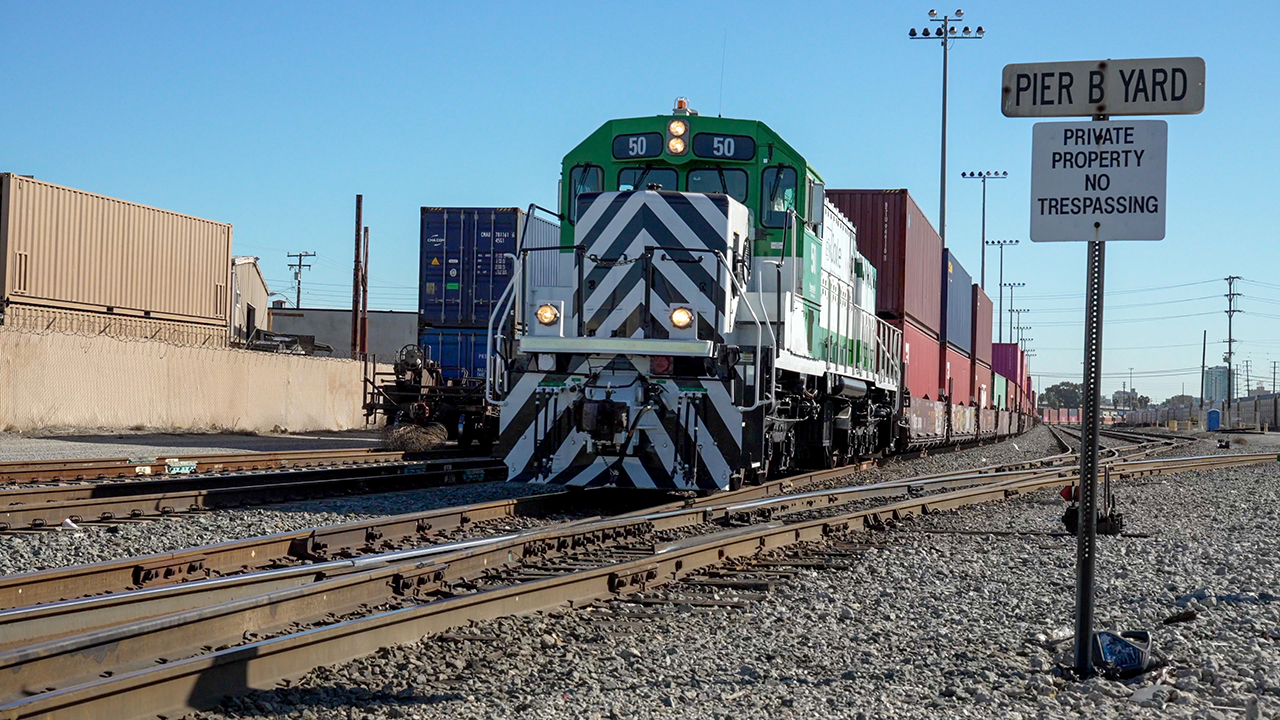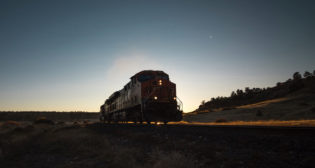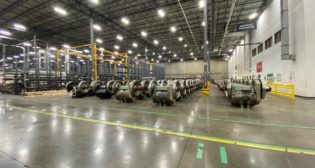
Engines of Change
Written by William C. Vantuono, Editor-in-Chief
It looks like a diesel-electric. It acts like a diesel-electric. But it’s not a diesel-electric. It’s the Progress Rail EMD® SD40JR Joule battery-electric, seen here operating in regular service on Pacific Harbor Line. Progress Rail photo.
RAILWAY AGE, MARCH 2024 ISSUE: The locomotive market is in a state of flux with numerous options in multiple stages of design and test.
Apologies for the all-too-obvious wordplays, but the market for battery-electric (BE) locomotives is “all juiced up.” Likewise, for hydrogen fuel cell (HFC) power, “it’s a real gas, man,” regardless of whether the hydrogen comes in cryogenic (liquefied) or compressed form (p. 24). Hybrid locomotives, which employ a combination of diesel engines and batteries, and are capable of regenerative and external battery charging, are a promising blend of traditional and next-generation power. ICE (internal combustion engine) power that substitutes hydrogen for diesel fuel is another option. LNG (liquefied natural gas) is still around, though interest has waned with advances in battery and HFC technologies. And let’s not forget the healthy market for rebuilding older diesel-electrics to fuel-efficient, greener Tier 3 standards. Acquiring new Tier 4 power is of course an option, but the cost is about double that of a remanufactured, upgraded unit. Follow the money that’s being saved.
It’s going to require a lot of time for the industry to throughly evaluate and prove out the options that can help it achieve the theoretical goal of “ZE” (zero emissions). Is ZE realistic? Well … maybe. The only certainty is that the path to diesel-electric locomotive replacement with next-gen power will leverage a wide variety of technologies.
Sometime between 2050 and 2100, readers of 200-plus-year-old Railway Age should expect to see a mix of BE, HFC, hydrogen ICE, LNG, hybrid and traditional diesel-electric locomotives operating across North America in every possible environment, from linehaul to classification yard to industrial switching, in an industry approaching 300 years old.
Without question, electric locomotives drawing power from catenary will continue to have an important role in passenger rail. The Northeast Corridor should have third-generation Acela trainsets and locomotive-hauled railcars operating alongside the latest NJ Transit, SEPTA, MBTA and MARC “motors,” with dual-power units in the mix. Caltrain’s ambitious electrification program may be built out well beyond today’s startup phase. California High Speed Rail linking Los Angeles with San Francisco with 200-mph trains will hopefully be fully built out. And who knows? There may be a few Class I freight railroads that decided to electrify, given an abundance of available wind, hydro-electric and solar power.
PROGRESS FOR PROGRESS RAIL
The EMD Joule, one of Progress Rail’s alternative propulsion initiatives, is available in five configurations, new or repowered (“R” nomenclature)—SD70J (6 axles, 8.0 MWh maximum battery capacity); SD70J-BB (8 axles, 14.5 MWh); SD40JR (6 axles, 4.0 MWh); GT38JB (4 axles, 4.0 MWh); and GT38JC (6 axles, 4.0 MWh). All feature regenerative braking for battery recharging. The modular EMD® Joule Charging Station provides stationary charging in 700- and 1,400-kW configurations.
An SD40JR is now in the midst of a one-year pilot program at Anacostia Rail Holdings’ Pacific Harbor Line at the Port of LA/Long Beach. No 50, according to Progress Rail Director of Electrical Systems Sidarta Beltramin, is performing well in day-to-day operations alongside traditional units, sometimes in multiple-unit lashups but mostly as a standalone. The response from train and engine crews has been positive.
“PHL has been using the locomotive consistently,” says Beltramin “We’ve been refining some features, and we’re obtaining more and more knowledge every day on how the unit is performing. In terms of what we expected from testing at MxV Rail and what the unit is delivering at PHL, its performance has been what we predicted. During testing, we tried to simulate worst-case scenarios that we could encounter in a real-world application. So far, the performance correlates well with what we tested, in terms of performance in general and how the batteries are functioning. It’s quite consistent. It performs or handles similarly to a diesel-electric unit, but it’s different because it’s quiet. We purposely configured it to perform like a diesel so PHL doesn’t need to change its operating practices or retrain crews. We did not set it up to provide instant power. Rather, we matched the performance of the existing fleet.”
The 14.5 MWh SD70J-BB offers “the largest known battery capacity in the industry,” according to Progress Rail. In Australia, BHP Western Australia Iron Ore and FMG (Fortescue Metals Group) are this year each expected to receive two currently under manufacture at the company’s Sete Lagoas, Brazil facility. BHP’s test will utilize regenerative braking (“energy capture”) battery charging using natural topography to reduce overall power demand. On the downhill run to BHP’s Port Hedland facility from its mine in the Pilbara, the locomotives will capture regenerative braking energy to help power empty trains back to the mine, “a great illustration of how battery-electric locomotives can work in a heavy-haul environment.”
Elsewhere, BNSF is expected to take delivery this year of up to four 8 MWh SD70Js. The acquisition is funded in part by CARB (California Air Resources Board) and EPA grant funding. Brazil’s Rumo Logística now has two EMD® GT38H intermediate-power meter-gauge hybrid locomotives in revenue freight service, following track upgrades, in a one-for-three substitution (one GT38H replaces three diesels). These use modular architecture to accommodate various energy sources, retain the capability of their diesel counterparts, and are capable of regenerative and external battery charging.
Progress Rail’s HFC initiative is a program involving parent company Caterpillar, BNSF and Chevron U.S.A. Inc., the goal of which is “to confirm the feasibility and performance of hydrogen fuel for use as a viable alternative to traditional fuels for linehaul rail. Hydrogen has the potential to play a significant role as a lower-carbon alternative to diesel fuel for transportation, with hydrogen fuel cells becoming a means to reduce emissions.” Design is progressing on a prototype.
Overall, on BE locomotives, Beltramin notes, “We are learning a lot, improving subsystems, software, and the behavior of the vehicle in real-world applications.”
Wabtec: Hydrogen’s Potential
Hydrogen has “enormous potential,” says Wabtec, “but the transition is a complex endeavor that is beyond the capabilities of any single company.” The company’s hydrogen public-private partnerships include collaborative research and development agreements with Oak Ridge, Argonne and Sandia National Labs. Wabtec is also working with the Department of Energy Office of Science to install a single-cylinder dual-fuel locomotive engine in the National Transportation Research Center on the Oak Ridge National Lab campus. This collaboration “presents exciting possibilities for the rail industry,” Wabtec says. “There is a large installed base of more than 20,000 locomotives that could be retrofitted to burn hydrogen. This option would enable railroads to maximize the investment in their current fleets, while converting the locomotives to a clean-burning energy source.”
The Argonne work is focusing on modeling hydrogen injection and combustion. The four-year project will use the lab’s high-performance computers in collaboration with software developer Convergent Science, Inc., to develop simulation software, to test and predict combustion engine behavior under changing operating conditions and hardware modifications, speeding the development process. The Sandia work, funded by a federal grant, will develop proposed hydrogen standards and regulations for the rail industry. The Federal Railroad Administration and the Association of American Railroads Alternative Fuel Tender Technical Advisory Group also participated in Sandia research on safety and design requirements for hydrogen fuel locomotives.
Wabtec and Sandia documented the Risk Assessment of Design and Refueling for Hydrogen Locomotive and Tender, a project “that gives the regulatory community and industry vital information when developing technical standards for the hydrogen economy.” The company is also active in the Fuel Cell & Hydrogen Energy Association “in informing federal policies, along with regulations, codes, and standards.”
Wabtec is also at work on HFC locomotives. “Hydrogen fuel cells do not yet have the power density to power a road locomotive,” the company says. “We are working with various suppliers to develop fuel cell solutions for locomotive applications.”
Hydrogen-powered locomotives “will require a complete infrastructure overhaul,” Wabtec stresses. “The primary barriers to a hydrogen-powered rail industry include the high cost of green hydrogen in comparison to diesel fuel; lack of storage and refueling facilities that provide access to the fuel along rail routes; and railroad operational changes around safety procedures, crew and craft training, labor union agreements, maintenance, coordination with first responders in the case of incidents and accidents.”
The Infrastructure Investment and Jobs Act (IIJA) set aside $8 billion in federal funding for the development of the Regional Hydrogen Hub program at the Department of Energy. This program aims to build out key components of the hydrogen infrastructure at seven regional hydrogen production hubs targeted to produce up to one-third of the hydrogen needed in the market.
Wabtec says it contributed to the DOE’s hydrogen hub implementation strategy and also supported applications to secure a share of government hydrogen hub funding. The company worked with HyVelocity, a collaboration by non-profit research organizations and academia on the Gulf Coast, and supported the Machh2 Alliance for the Midwest regional hydrogen hub.
“Fueling a locomotive with hydrogen would be time-consuming,” Wabtec notes. “It currently takes under 30 minutes to fill a 5,000-gallon diesel tank. Refueling an equivalent amount of gaseous hydrogen would take 6.5 hours, disrupting logistics, and negatively affecting asset utilization. Yet even before the refueling issue can be addressed, locomotive operators need infrastructure that provides access to low-carbon hydrogen. Most hydrogen is produced via electrolysis, which requires affordable and abundant water and electricity. Rarely are these hydrogen production resources located near railyards, creating a transportation and storage challenge.
“With the appropriate safety features and regulatory support, rail could be the ‘virtual pipelines’ for the hydrogen economy of the future. Rail could easily connect to hydro-gen production facilities with distribution networks that will fuel locomotives and other modes of transportation. Transporting hydrogen by rail is more cost efficient, faster to implement, and offers greater flexibility over pipelines than using trucks. Rail transport brings the fuel closer to users via existing infrastructure. Railcars used to transport hydrogen can also function as on-site storage tanks to further reduce infrastructure build-out costs. The infrastructure will also need equipment that meets railway standards for larger scale, heavy-duty applications.”
Innovative Initiatives
There are numerous other programs to develop next-gen locomotives. Among them:
Dominion Energy, designated as the leader of a project funded by the Texas Military Preparedness Commission to improve energy resilience for rail operations at Fort Cavazos, Tex., has selected Innovative Rail Technologies (IRT) to provide its ATLAS lithium-ion battery-electric propulsion system. The project, which was the top-scoring proposal chosen for the funding and will result in conversion of one of the U.S. Army’s diesel locomotives to BE, “provides Fort Cavazos not only with a cost-effective way to update and expand mission capabilities of one of its aged legacy diesel locomotives with IRT’s state-of-the-art ATLAS propulsion technology, but also to collaborate with the electric utility service provider and federal, state and local government officials on base readiness, infrastructure resilience, community coordination, and environmental justice objectives,” according to IRT. “The battery system on ATLAS locomotives is capable of providing a significant source of backup power during emergency events, including cyberattacks, providing an additional layer of operational readiness.”
IRT has begun the rebuild of the Fort Cavazos locomotive and is expected to deliver it to Fort Cavazos by the end of 2024.
Palmetto Railways (PR), a division of the South Carolina Department of Commerce and Railway Age’s 2015 Short Line Railroad of the Year, is partnering with IRT to convert two diesel-electric switcher locomotives to lithium-ion BE power. The locomotives are expected to be delivered and begin service within two years.
In September 2023, PR received a $4.17 million FRA CRISI (Consolidated Rail Infrastructure and Safety Improvements) grant for this project; PR will provide a 35% non-federal match. The conversion to BE is expected to reduce diesel fuel consumption at PR facilities by an estimated 40,000 gallons annually per locomotive, while “providing additional resiliency to the local grid infrastructure and to local rail supply chain partners and customers,” the railroad said. “The ZE locomotives will help maximize a cleaner and more energy efficient transfer and shipment of goods through Palmetto Railways’ existing North Charleston facilities and will support the Navy Base Intermodal Facility currently under construction with South Carolina Ports Authority.”
IRT, established in 2019, noted it “has a rapidly expanding list of customers that includes Fortune 500 companies, ports, industries, and short line railroads. IRT works with its growing nationwide network of locomotive remanufacturers (ATLAS Authorized Installers) and can also provide ATLAS kits directly to customers for in-house remanufacture.”
In July 2023, Alberta-based Cando Rail & Terminals began developing a BE switching locomotive through its Li-Ion 2025 Project, which involves retrofitting a non-tier-compliant diesel-electric locomotive with a lithium-ion battery propulsion system. The locomotive will be a “scalable solution customized for the company’s In Yard Operations (IYO) or closed-loop switching operations.” IRT is part of this project.



